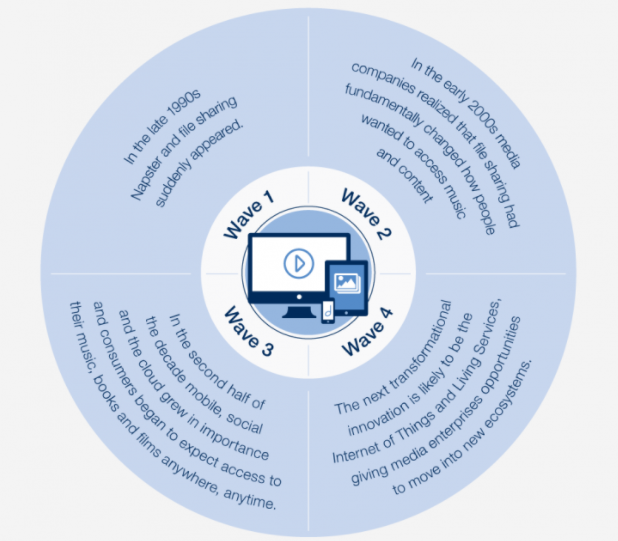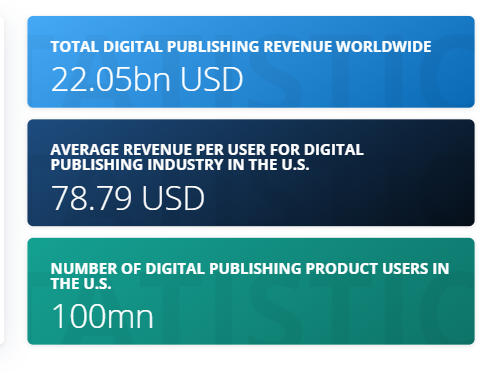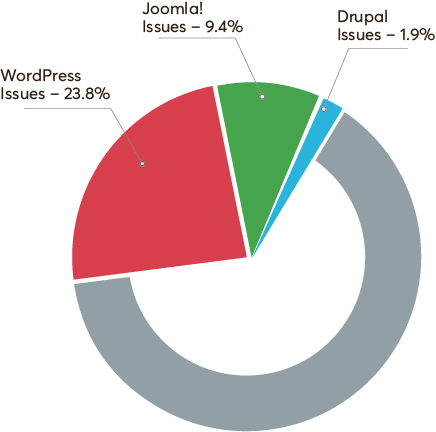Every morning we get up and something big has happened somewhere in the world. Sitting in the capital of India, we get to know how the inaugural ball went on in the capital of the United States. And how are we able to get this knowledge?
It is the media and publishing industry that constantly reports all the national and international happenings to our households. From getting to know about election results to knowing the extent of natural calamities and political unrest, we know it all.
The role of the media is all the more important today, it has essentially become the voice of the voiceless all over the world. With such a magnitude of responsibility, the media and publishing businesses need to be at their A-game all the time.
Today, we’ll try to understand how they can enhance their online presence for a rich user experience with the help of Drupal. Before doing that, let’s shed some light on the changes in this industry and understand the consequent change in their web needs.
What changed over the years?
Time changes everything and everyone. People change their appearances, their style and their thought processes over time. Something that may be important for them is highly likely to become trivial in the distant future. This is what happened to people’s perspective towards the media and publishing industry and the change in point of view led to a substantial change in the running and management of this industry.
Think of a decade ago, were we as dependent on smartphones and other mobile devices as we are now? The answer is no. However today, from teenagers to the elderly, everyone is glued to their third limb, being the smartphone or smart devices in general. Look at the usage in the graph below to get a clearer idea.

Once reading a news article on a smart gadget was a novel thought. However, today it is an everyday occurrence. And that is the pivotal shift that the media and publishing has had to take. The readers are more inclined to reading news updates on their phones. And that is why, this sector has had to transcend from print and paper and provide their audience with digital platforms that are easy to access anytime, anywhere and on any gadget.
What the change comes down to is the delivery mechanism. The media and publishing outlets are performing their duties much in the same way. They are reporting much in the same way. The stories that need to be told are being told and the questions that need to be raised are being raised. However, all of this is happening on digital platforms and it happened in four phases.

I wouldn’t say that the physical medium of media has become antiquated, not by any means. I still see my dad having his morning tea with a side of the front page news of The Times. However, he also gets constant updates on his phone about the world happening without having to wait for the next day’s paper.
And that is the change that has happened, that is how the evolution of the media and publishing industry took place, with the core values still remaining the same.
Look at this report by Statista to understand the emergence of digital media platforms. With such a substantial amount of revenue, I’d say it has come out with a bang.

What do media and publishing houses seek today for digital presence?
Like we just discussed above, the media and publishing houses have transformed a great deal in the way they relay information to their audience. Today, there isn’t just one kind of audience and you can’t just build your entire persona around that one category. From young people perusing news on their smartphones to the minority population fluent in their own regional language, the media and publishing industry has to be able to provide for the diversity they have in their audience.
With the move towards digitalisation, we are going to take a look at the needs and requirements of this sector as they are in the present day.
Ease of publishing
The primary purpose of a media and publishing business is to provide its audience the content that they need. This purpose mandates that the site has an enhanced ease in editing and publishing content, be it blogs, articles or press releases. These content pieces should not be limited to text, images, audios and videos are as equally important as the powerful words of a news writer, and that is the first requirement of this sector today. Faster production and publication of content across multifarious channels is key.
Friendliness towards the search engines
Now that we have published the article with ease, the next major requirement is to ensure that it reaches the audience it was intended for. If I talk about myself, I always end up at Google whenever I want to read about a major or even minor happening in the world. This is true for most of the readers out there. That is why, Search Engine Optimisation is essential today.
Producing SEO friendly content would help your content become all the more visible to a wider audience and garner organic traffic for your site. With over 3.5 billion searches everyday on Google, I’d say there isn’t any harm in taking advantage of SEO by adding the necessary words and phrases to your articles. Everything about SEO and its implementation can be accessed here.
Amiability to social media
Social media is a game changer for the media and publishing industry, allowing it to take its content across the globe in mere seconds. Therefore, social media integration is key, with Facebook becoming the front runner, being that it is the largest platform.
Having a social media handle, providing sharing options on your articles and creating custom posts of your social media handles, all three of these would lead to a streamlined integration with social media channels. With over half the world population using these platforms, it is only wise.
Responsiveness of design
Next major requirement for the media and publishing industry in going digital is the need to be responsive. Websites that can only be browsed efficiently through a desktop are essentially doomed for failure. Being responsive to all sorts of mobile devices, especially the smart phones, is integral to media outlets. Accelerated Mobile Pages are a trend that more and more websites are following. These help in delivering a smooth experience of browsing for all your users across all the touchpoints. Here is your complete guide to web design.
Warmth of personalised experiences
Coming to the final requirement, which is personalisation. Every web user today is treated differently, since they have different taste. We, as web developers, become aware of these tastes through web cookies. Therefore, as a media and publishing site, you have to become aware of your audience’s likes and dislikes and provide a personalised experience for them that they end of loving. Informational noise and never-changing ads need to be left in the previous decade. Your complete guide to web personalisation is available here.
Why is Drupal great for the media and publishing industry?
Sports, FMCG, Food, FinTech, Elearning, Government, healthcare, nonprofit, travel, or whatever website you need to build and whichever industry segment you belong to, Drupal has just the right ingredients to build your digital presence. Media and publishing industry is no different.
Drupal is an open source Content Management Software that has a worldwide presence and is renowned for its efficiency in managing content. It has clientele from multitudinous trades and businesses. And with a community of over a million, it is indeed a force. It is a force that is equipped to provide digital experiences that enable you to connect with your audience no matter where they are.
I would not get in every minute aspect of Drupal, because that’ll make this blog quite lengthy and nobody wants that. Rather I would only talk about those aspects of Drupal that make it extremely compatible with the media and publishing industry. So, here goes.
Drupal eases content management and distribution
The thing about media sites is that they are not limited to just one, they have a huge family with many subsidiary sites. The higher number of co-dependent sites means that you would have to have a lot of content to deal with. Drupal comes quite handy here, as it acts as a single home for all the sites.
And the amount of content that results in would not be bother as well. Be it photos, videos, audios, podcasts or graphs and analysis. Everything would be seamless in terms of production, management and distribution with Drupal. Have a look at an example of how content authoring can be performed at ease with modern solutions like Layout Builder module in Drupal core.
Drupal eases the mobile transition
I believe I am going to be mentioning this one for a third time now, but mobile responsiveness is pretty high on the priority list so it deserves another mention. When we talk about user engagement, a modular design is key and when that design is flexible to respond to any device the engagement soars. Drupal provides a number of modules to achieve the same. To know more, read about mobile-first approach and Drupal’s provisions for building mobile solutions at scale.
Drupal eases multilingualism
With media sites catering to a large number of audience worldwide, language can become a problem. Drupal provides multilingual support that makes publishing the same content in different languages an ease. Drupal offers translations in as many as 94 languages. More on Drupal’s multilingual capabilities here.
Drupal eases profits and lessens costs
Drupal is equipped to make you money as well. Advertisements, promotions, subscriptions and one-purchases, all are inclusive in Drupal modules that result in media outlets being more profitable.
Then is the fact that Drupal is open source, which means it is free of cost. There isn’t any licensing fee required to be paid. All you need to do is install and configure it and you’ll be ready to go. Learn more about the perks of contributing to an open source CMS like Drupal and being a part of a growing open source community here.
Drupal eases the security concerns
Drupal security is one of the best in the market. With modules for authentication, password protection and encryption, your data is always going to be safe. Open Source security isn’t anything to be taken lightly and Drupal has proven that. Here is a survey to prove that.

With this level of ease, you can become relaxed and bask in the efficiency of Drupal and become free of the burdens of running a media site that you might have to endure otherwise. However, you would have to write stellar pieces that are able to resonate with the audience and accomplish what they were set out for. That is a burden you would have to bear, Drupal wouldn’t be able to do so.
Here is a glimpse of Drupal at work with digital media houses
Drupal has indeed proven to be one of the best CMSs for the media and publishing industry. I don’t just say it for the sake of it, I come bearing proof. OpenSense Labs has worked with many media and publishing houses to build impressive experiences for their web portals with Drupal and here are some of these sites.
Men's Health
Men’s Health magazine is a global brand, which publishes in close to 60 countries. It required a software that would provide an ease of management for the content authors, with an adaptable content architecture that would be responsive and browser agnostic. It also required to balance the performance and images conundrum without trading off on either of these. And Drupal was able to fulfil all of these requirements and an impressive digital experience was created.
Read the complete case study of Men’s health to know more.
Earth Journalism
Earth Journalism Network is a leading non-profit environmental new network that aims to improve the quality and quantity of environmental reporting. With such crucial work, it required the best. Drupal provided ease in publishing and managing varying categories of content types with a heightened flexibility. Drupal also had the right kind of core and contributed features that allowed for better design scope and ability to handle enormous amounts of content.
Here is the detailed case study of Earth Journalism Network.
Farm Journal
Farm Journal is a leading US publication site for agricultural news with a host of subsidiary sites serving varying sectors of this industry. With such a magnitude of services, its content needs were becoming a challenge. Drupal was able to overcome this challenge with ease. Customer sites were enhanced, upgrades were made faster and convenient, the architecture was made scalable and modular in nature and most importantly, the content journey, from the editors hitting save to the consumer clicking read, was reduced to mere seconds.
To know about everything that went on in the Farm Journal project, read this case study.
AgWeb
A part of the Farm Journal brand, AgWeb was able to improve its brand identity as well as user engagement with Drupal’s help. Being an agricultural news site, AgWeb needed to improve its web performance, at the same time the site’s SEO needed to be kept intact, while improving the site’s web SERP rankings. ReactJS was also implemented as part of progressive decoupling for a better frontend experience.
Take a look at the AgWeb case study to understand the project better.
All of these are a blatant proof of Drupal’s efficiency in this constantly evolving domain of publishing and you would be wise to choose it.
Conclusion
The news, newspaper and article sites are growing at an impressive pace. Therefore, having a CMS in your corner that is powerful enough to let you scale in accordance to the growth rate is ideal. Drupal is just that, it can do and achieve things for a media site that other CMSs may not be able to. And we at OpenSense Labs have actually witnessed that with all media projects. So, trust me when I say that you cannot go wrong with Drupal. For any doubts you may still please feel free to contact us.
Subscribe
Related Blogs
Inside the Drupal AI Summit: Themes, Speaker and What To Expect

“ The web is changing fast, and AI is rewriting the rules. It writes content, builds pages, and answers questions directly,…
FOST and Drupal AI Initiative: Next Era of Responsible AI

Three years after the launch of generative AI tools marked a new age for artificial intelligence, almost 90% of survey…
Drupal AI Ecosystem Part 5: AI Content Suggestions

Drupal has steadily evolved from being just a content management system into a flexible platform that incorporates emerging…




